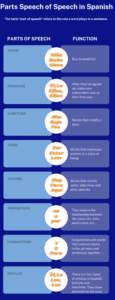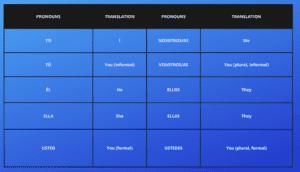After learning some basic greetings in Spanish, one of the most important categories to learn next are parts of speech in Spanish. This is a definite must before going into verb conjugation in my opinion.
You’ve probably heard your Spanish teacher use terms such as sustantivo (noun), verbo (verb), and artículo (article) in class, but what do they mean?
What you’ll learn today, is being able to identify these terms. We will go over the 9 parts of speech in Spanish. Understanding how to use these terms can even help you learn how to converse in Spanish faster!
¡Vamanos! Let’s go!
What is a “Part of Speech”?
We all can agree there are thousands of words that exist in English and Spanish. Parts of speech exist to help categorize and identify a different kind of words.
Parts of speech group words together based on their function in a sentence. In Spanish, the main parts of speech are
- Noun
- Pronoun
- Adjective
- Verb
- Adverb
- Preposition
- Conjunction
- Article
Parts of speech are one of the most essential Spanish grammar rules for beginners. So grab your notebook to take notes and learn these nine categories!

NOUNS

A noun is a person, place, thing, or idea. Usually, nouns will be the subject of a sentence. For example,
The computer is expensive.
Here “computer” is the noun because it is the “thing” in this sentence. And It also happens to be the subject.
Using Nouns
In Spanish, the noun is called ” el sustantivo” and it works the same way as it does in English except for one major difference: gender. In Spanish nouns are actually classified as either “masculine” or “feminine.” The best way to identify if a word is masculine is by looking at the articles. We will talk about those later in this blog. But the other way is taking a look at the endings. Let’s take a look at the chart to see which endings are masculine or feminine. Please note, that the endings that you see here are not all the endings but ones that for sure follow a specific pattern.
Most nouns end either in an “-o” or an “-a.” The vast majority of the time words with an “-o” at the end are considered masculine and words ending in “-a” are feminine:
| Masculine endings: | Feminine endings: |
| -ma | -ción |
| -ía | -sión |
| -o | -dad |
| -or | -tad |
| -án | -ie |
| -ambre | -eza |
| -aje | -sis |
| -itis | |
| -tud | |
| -umbre |
There are some nouns which don’t follow this rule (of course) and other nouns which end with a different letter entirely. For those words, you’ll just have to memorize the gender along with the word.
It’s easy to make nouns plural in Spanish. Add “-s” to words ending in vowels, and add “-es” to words ending in consonants:
| singular: | plural: |
| teléfono | teléfonos |
| bicicleta | bicicletas |
| coche | coches |
| papel | papeles |
| rey | reyes |

Definite Articles
Definite articles specify which object, person, or place the speaker is talking about.
“The” is the only definite article in English. In Spanish, however, there are 4 definitive articles:el, los,la, and las .
Indefinite Articles
Indefinite articles are used to express a general noun. “A” and “an” are the only two English indefinite articles that exist. Just like in English, the articles will come before the noun.
| Person | Definite article | Indefinite article | |
| masculine | sg . | el | un |
| pl. | los | unos | |
| feminine | sg. | la | una |
| pl. | los | unas | |
PRONOUNS

In Spanish, there are 8 kinds of pronouns but we will focus on the subject pronouns. These kinds of pronouns will be an important part of verb conjugations.
Spanish Subject Pronouns
Subject pronouns are the most common type of pronouns that we use. They are broken down by the gender and number of the noun they replace. They tell us who is doing the action in a sentence. Subject pronouns are very important because these are the types of pronouns that we base on when conjugating verbs.
| Person | Spanish | English |
| 1st person singular | yo | I |
| 2nd person singular | tú | you |
| 3rd person singular | él, ella | he, she |
| 1st person plural | nosotros | we |
| 2nd person plural | vosotros | you |
| 3rd person plural | ellos, ellas | they |
ADJECTIVES

Adjectives are words that describe nouns. Just as in English, there are different kinds of adjectives. They can have different functions according to the role they play relative to the word they modify. One function for an example is to limit or determine a noun. There are four kinds of adjectives. Possessive, Demonstrative, adjectives that serve as nouns and descriptive adjectives. There is one more thing to know about Spanish adjectives. They must match the gender and the quality of the noun.
Masculine adjectives that end in -o drop the -o and add -a for the feminine forms. To form the plural, both masculine and feminine, add -s to the singular ending. If the adjective ends in -e, add -s for the plural. If it ends in a consonant, add -es.
Example:
El coche rosado. (The pink car.)
“Car” is masculine and therefore the masculine form of “pink” needs to be used.
La flor rosada. (The pink flower.)
“Girl” is feminine and therefore “tall” has to be used in its feminine form.
This is also true of plural nouns and plural adjectives. If the noun is in the plural you need to adjust the adjective:
Las flores rosadas. (The pink flowers.)
Los coches rosados. (The pink cars)
Where Does an Adjective Go in a Spanish Sentence?
Descriptive or Qualifying adjectives will usually go after the noun. These include those that describe physical characteristics or nationalities or are derived from verbs.
Una silla blanca (A white chair)
Un hombre inglés (An English man)
These identifying adjectives include demonstrative adjectives, for example, este (this) or aquel (that). These types of adjectives always precede the noun. The same is true for possessive adjectives which explain who the noun belongs to, for example, mi (my) or nuestro (our).
If an adjective is a limiting adjective then it also goes before the noun. A limiting adjective is one that somehow limits the noun in quantity. For example:
Tengo suficiente comida para la fiesta. (I have enough food for the party.)
The limiting adjective is suficiente (enough) and since it limits comida (food), it goes before the noun. This also applies to numbers. Yes numbers are adjectives.
Adjectives that give emotional impact, or express essential “qualities” will also go before the noun.
El fiero pajaro. (The ferocious bird.)
Putting fiero first shows the emphasis on “ferocious,” and refers to an essential characteristic.

Verbs are action words.
Verb conjugation really consists of two steps:
- Identify who are you talking to or about?
- Add the appropriate ending.
When conjugating Spanish verbs in the present tense, first identify who’s performing the action. This is your “subject.” Remember the subject pronouns that we learned at the beginning of this blog? They’re back! There can be eight possible subjects:
- Yo — I
- Tú — you (singular informal)
- Usted — you (singular formal)
- Él/ella — he, she
- Nosotros/nosotras — we
- Vosotros/vosotras — you (plural informal)
- Ustedes — you (plural formal)Ellos/ellas — them
- Ellos/ellas — them
Note that although there are eight subjects, there are only six forms of verb conjugation. Él, ella and usted (he, she, you) are conjugated the same, as are ellos, ellas and ustedes (them, plural you).

When conjugating Spanish verbs we have to identify their infinitive endings (a.k.a. the dictionary version of the verb). They will end in either -ar, -er or -ir.
To conjugate, an infinitive verb, remove the final two letters and add the appropriate ending.

The appropriate ending depends on
- which tense you’re using (i.e. do you want to talk about the past, present or future?)
- which mood you’re using (i.e. are you asking a question, stating a desire or making a command?)
- whether the verb is regular or irregular

Adverbs are words that modify verbs, adjectives and other adverbs. Spanish adverbs will usually end in the suffix “-mente” which is the English equivalent to “-ly”.
To form and adjective in Spanish, we have to make the adjective feminine and add the suffix “-mente”.
Remember that not all adjectives have an exclusively feminine form, so sometimes it will just remain as it is.
For example, claro (clear) will change to clara, and felíz (happy) will not have to change.
Third, add “-mente” to the end of the adjective.
- claramente (clearly)
- Felízmente (happily)
This cannot be done with every adjective in Spanish, just as it cannot be done with every adjective in English.

| A | To, at |
| Ante | Before |
| Bajo | Under |
| Con | With |
| Contra | Against |
| De | Of, from |
| Desde | From |
| Durante | During |
| En | In, on, at |
| Entre | Between, among |
| Hacia | Toward |
| Hasta | Until |
| Mediante | Through, by way of |
| Para | For, in order to |
| Por | For, by |
| Según | According to |
| Sin | Without |
| Sobre | About, on, over |
| Tras | After, behind |
| Vía | Via |
A preposition is a word that indicates information about location, place, or movement. It also provides a link between different parts of sentences. The location of a preposition will generally go before a noun or a pronoun. There are different types of prepositions. The most common is locations, time, and frequency.
CONJUNCTIONS

Conjunctions are words that connect nouns, verbs, phrases, and sentences. They help you piece together different ideas.
There are two main types of conjunctions: simple and complex. The simple conjunctions are the ones that you use all the time. In English, they are “and”, “but”, and “or”. Complex conjunctions, on the other hand, have a little more depth.
Simple Spanish Conjunctions
- y – and
- o – or
- pero – but

Articles draw special attention to the noun that they precede. The type of article shows the way that the speaker is thinking about the noun. The speaker could be talking about the noun in a general sense or as a specific item. The two distinct types of articles are definite and indefinite.
Definite Articles
Definite articles specify which object, person, or place the speaker is talking about.
“The” is the only definite article in English. In Spanish, however, there are 4 definitive articles: los, las, el, and la.
Again, these artículos change depending on the noun that they precede.
- Masculine singular: el
- Masculine plural: los
- Feminine singular: la
- Feminine plural: las
Let’s look at some examples.
La maestra pone el lápiz en la mesa.
The teacher puts the pencil on the table.
El perro corre en el patio.
The dog runs in the yard.
Indefinite Articles
Indefinite articles are a nonspecific way to refer to a noun. “A” and “an” are the only two English indefinite articles that exist. However, in Spanish, there are four.
Again, these artículos change depending on the noun that they proceed.
- Masculine singular: un
- Masculine plural: unos
- Feminine singular: una
- Feminine plural: unas
Look how the sentences change with indefinite articles.
Una maestra pone un lápiz en una mesa.
A teacher puts a pencil on a table.
Un perro corre en un patio.
A dog runs in a yard.
BONUS
INTERJECTIONS

Interjections are abrupt expressions that help you to express different emotions. They also help to improve your Spanish by making it sound more native!
Interjections are a fun part of Spanish grammar for beginners because a good handful of them are short words or phrases. So it makes them easy to remember. Plus, native speakers will love hearing you use these natural Spanish sounds.
Common Interjections in English
- ahh
- alas
- alrighty
- shucks
Common Interjections in Spanish
- ¡Vale!
- ¡Dios mío!
- ¡Venga!
- ¡Ay!
Interjections can vary in their meaning. Context is extremely important to help decode them. Volume, pitch, and speed can also help show meaning. Interjections can also be filler words. They are a way to fill in a space or pause while the speaker thinks of the next thing they want to say. In this way, they are a means of not giving up airtime or preventing someone from interrupting.
Take a look at how interjections add emotion and feeling to these sentences.
¡Venga! La maestra ya ha empezado la clase.
Come on! The teacher already started class.
¡Ay! El perro está fuera del patio.
Hey! The dog is outside of the yard.
Understanding the parts of speech is beneficial for analyzing the meaning of each word. Also, by learning them you can easily identify a grammatical problem in the sentence, and see whether there is a run-on sentence, a misused pronoun, or a problem with the verb agreement. For more practice check out our Spanish group classes here on TakeLessons Live.
Rosita Ruiz
